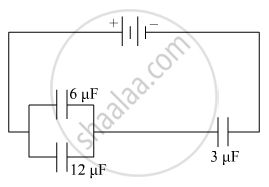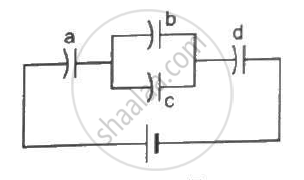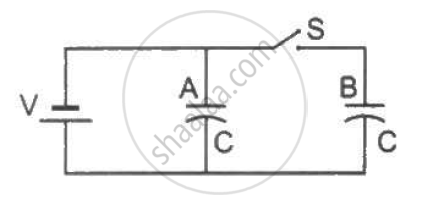Advertisements
Advertisements
Question
A capacitor C1 of capacitance 1 μF and a capacitor C2 of capacitance 2 μF are separately charged by a common battery for a long time. The two capacitors are then separately discharged through equal resistors. Both the discharge circuits are connected at t = 0.
(a) The current in each of the two discharging circuits is zero at t = 0.
(b) The currents in the two discharging circuits at t = 0 are equal but not zero.
(c) The currents in the two discharging circuits at t = 0 are unequal.
(d) C1 loses 50% of its initial charge sooner than C2 loses 50% of its initial charge.
Solution
(b) The currents in the two discharging circuits at t = 0 are equal but not zero.
(d) C1 loses 50% of its initial charge sooner than C2 loses 50% of its initial charge.
Let the voltage of the battery connected to the capacitors be V. Both the capacitors will charge up to the same potential (V).
The charge on the capacitors C1 is C1V = (1 μF)×V
The charge on the capacitors C2 is C2V = (2 μF)×V
The charge on the discharging circuit at an instant t,
\[Q = CV e^{- t/RC}\]
The current through the discharging circuit,
\[\frac{dQ}{dt} = - \frac{CV}{RC} e^{- t/RC} = \frac{V}{R} e^{- t/RC}\]
At t = 0, the current through the discharging circuit will be `V/R` for both the capacitors.
Let the time taken by the capacitor C1 to lose 50% of the charge be t1.
\[Q_1 = \frac{C_1 V}{2}\]
\[\frac{C_1 V}{2} = C_1 V e^{- t_1 /RC} \]
\[\frac{1}{2} = e^{- t_1 /RC}\]
Taking natural log on both sides, we get:-
\[- \ln2 = - \frac{t_1}{R C_1}\]
\[ t_1 = R C_1 \ln2\]
Similarly,
Time taken for capacitor C2:-
\[t_2 = R C_2 \ln2\]
As, C1 < C2, t1 < t2
Thus, we can say that C1 loses 50% of its initial charge sooner than C2 loses 50% of its initial charge.
APPEARS IN
RELATED QUESTIONS
Obtain the expression for the energy stored per unit volume in a charged parallel plate capacitor.
Explain what would happen if the capacitor given in previous question a 3 mm thick mica sheet (of dielectric constant = 6) were inserted between the plates,
- While the voltage supply remained connected.
- After the supply was disconnected.
A 12 pF capacitor is connected to a 50 V battery. How much electrostatic energy is stored in the capacitor?
A 600 pF capacitor is charged by a 200 V supply. It is then disconnected from the supply and is connected to another uncharged 600 pF capacitor. How much electrostatic energy is lost in the process?
In the following arrangement of capacitors, the energy stored in the 6 µF capacitor is E. Find the value of the following :
(i) Energy stored in 12 µF capacitor.
(ii) Energy stored in 3 µF capacitor.
(iii) Total energy drawn from the battery.

A 20 μF capacitor is joined to a battery of emf 6.0 V through a resistance of 100 Ω. Find the charge on the capacitor 2.0 ms after the connections are made.
A capacitance C charged to a potential difference V is discharged by connecting its plates through a resistance R. Find the heat dissipated in one time constant after the connections are made. Do this by calculating ∫ i2R dt and also by finding the decrease in the energy stored in the capacitor.
By evaluating ∫i2Rdt, show that when a capacitor is charged by connecting it to a battery through a resistor, the energy dissipated as heat equals the energy stored in the capacitor.
Each capacitor in figure has a capacitance of 10 µF. The emf of the battery is 100 V. Find the energy stored in each of the four capacitors.

A capacitor with stored energy 4⋅0 J is connected with an identical capacitor with no electric field in between. Find the total energy stored in the two capacitors.
A capacitor of capacitance 100 μF is connected across a battery of emf 6 V through a resistance of 20 kΩ for 4 s. The battery is then replaced by a thick wire. What will be the charge on the capacitor 4 s after the battery is disconnected?
A capacitor of capacitance C is given a charge Q. At t = 0, it is connected to an uncharged capacitor of equal capacitance through a resistance R. Find the charge on the second capacitor as a function of time.
A capacitor of capacitance C is given a charge Q. At t = 0, it is connected to an ideal battery of emf ε through a resistance R. Find the charge on the capacitor at time t.
Figure shows two identical parallel plate capacitors connected to a battery through a switch S. Initially, the switch is closed so that the capacitors are completely charged. The switch is now opened and the free space between the plates of the capacitors is filled with a dielectric of dielectric constant 3. Find the ratio of the initial total energy stored in the capacitors to the final total energy stored.

Answer the following question.
Obtain the expression for the energy stored in a capacitor connected across a dc battery. Hence define energy density of the capacitor
A parallel plate capacitor has a uniform electric field `overset(->)("E")` in the space between the plates. If the distance between the plates is ‘d’ and the area of each plate is ‘A’, the energy stored in the capacitor is ______
(ε0 = permittivity of free space)
Do free electrons travel to region of higher potential or lower potential?
In a capacitor of capacitance 20 µF, the distance between the plates is 2 mm. If a dielectric slab of width 1 mm and dielectric constant 2 is inserted between the plates, what is the new capacitance?
